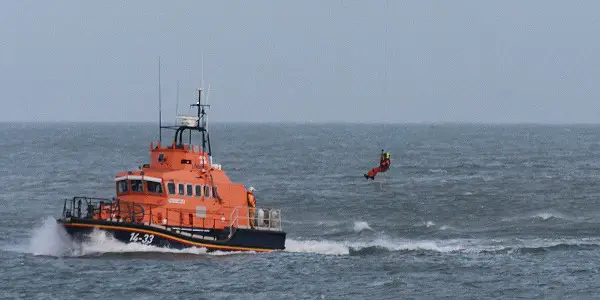At least 35 lives were saved by lifeboat crews as they rescued more than 1,200 people in Irish waters last year.
Howth in Co Dublin was the busiest RNLI station, with 60 launches and 58 people taken to safety, followed by the volunteers in Clifden, Co Galway, who put to sea 49 times and took 20 people to shore.
The busiest crew in Northern Ireland was on Lough Erne, where the team in Enniskillen answered 74 calls and rescued 89 people from its two bases on the upper and lower loughs.
In total the RNLI said crews launched 1,098 times, taking 1,244 people to safety, and filed reports that 35 people would have died without their work.
Sean O’Farrell, coxswain of Courtmacsherry lifeboat, recalled one incident last August where four adults and a young girl where taken from a sinking speedboat after going out on a fishing trip.
“They had changed the engine and as we discovered afterwards they neglected to plug the holes left from the old engine,” he said.
“They had difficulty stating their position and we missed them the first time, but when we arrived on scene one guy was lying on his stomach with his fingers plugging the holes.”
The party of five eastern Europeans had three buoyancy aids between them and were about a mile from shore.
It was feared the boat would have sunk within half an hour if the RNLI crew had not found them.
Mr O’Farrell added: “It shows the need to be prepared. Be aware of your surroundings. A lot of people come to the sea and are not fully aware of the the power of the water and the weather and end up in trouble very quickly.”
Among the more unusual call-outs were the rescue a herd of cows from the sea near Kinsale, Co Cork, including one animal which was stuck in a cave, and the discovery of the ocean rowing boat Happy Socks off Mizen Head three months after being abandoned by its owner in the middle of the Atlantic.
With 10 RNLI stations recording calls to help animals and pets in distress, experts warned over risks to people’s lives if they enter water themselves in an attempted rescue and get into difficulty.
Mr O’Farrell said: “Dogs are better able to swim in the sea than most people.”
Other figures from the RNLI revealed Lough Ree in Athlone had the highest number of rescues after the inshore lifeboat was launched 47 times and 130 people were taken to shore.
The benefit of having well-equipped stations was demonstrated on Lough Swilly in Donegal when the crew of a new Shannon class lifeboat rescued three fishermen on the boat’s first call-out.
The most common type of incident was mechanical failure on boats but 66 launches were in response to someone at risk of drowning.
